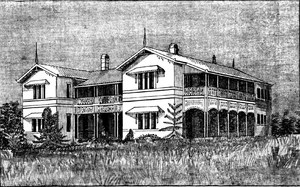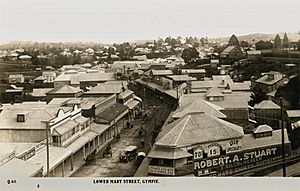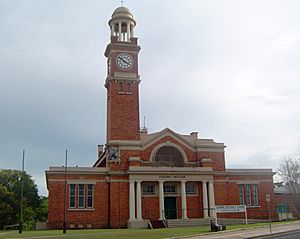Gympie facts for kids
Quick facts for kids GympieQueensland |
|||||||||||||||
|---|---|---|---|---|---|---|---|---|---|---|---|---|---|---|---|
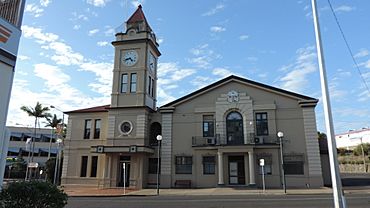
Gympie Town Hall, 2015
|
|||||||||||||||
| Population | 21,599 (2018) | ||||||||||||||
| • Density | 311.67/km2 (807.2/sq mi) | ||||||||||||||
| Established | 1867 | ||||||||||||||
| Postcode(s) | 4570 | ||||||||||||||
| Elevation | 73 m (240 ft) | ||||||||||||||
| Area | 69.3 km2 (26.8 sq mi)(2011 urban) | ||||||||||||||
| Location |
|
||||||||||||||
| LGA(s) | Gympie Region | ||||||||||||||
| State electorate(s) | Gympie | ||||||||||||||
| Federal Division(s) | Wide Bay | ||||||||||||||
|
|||||||||||||||
|
|||||||||||||||
Gympie is a city and a locality in the Gympie Region, Queensland, Australia. In the Wide Bay-Burnett District, Gympie is about 170.7 kilometres (110 mi) north of the state capital, Brisbane. The city lies on the Mary River, which floods Gympie occasionally. Gympie is the administrative centre for the Gympie Region area. As of June 2018 Gympie had a population of 51,578.
Gympie is famous for its gold field. It contains a number of historic buildings registered on the Queensland Heritage Register.
Contents
Etymology
Gympie's name derives from the Kabi (the language of a tribe of Indigenous Australians that historically lived in the region) word gimpi-gimpi (which means "stinging tree"), which referred to Dendrocnide moroides. The tree has large, round leaves that have similar properties to stinging nettles. The town was previously named Nashville, after James Nash, who discovered gold in the area in 1867. The name was later changed to Gympie in 1868.
History
Graziers were the original European settlers. Subsequently, James Nash reported the discovery of 'payable' alluvial gold on 16 October 1867. At the time of Nash's discovery, Queensland was suffering from a severe economic depression. Nash probably saved Queensland from bankruptcy. A memorial fountain in Gympie's Park honours Nash's discovery. The Gympie Gold Rush Festival celebrates the event today. The Gold Rush Festival holds 10 days of cultural events in October. Gold mining still plays a role in the area's fortunes, along with agriculture (dairy predominantly), timber and tourism. The gold rush's rapid development led to streets that are in an irregular fashion.
Gympie Creek Post Office opened on 1 December 1867. It was renamed Gympie in 1868.
The railway from Maryborough completed in 1881. The North Coast railway linked Gympie to Brisbane in 1891. A fire brigade was in operation in 1900. The state declared Gympie a town in 1903. A powdered milk factory began operations in 1953.
Flooding
Significant floods along the Mary River have caused inundations of the town in 1893, 1955, 1968, 1974, 1989, 1992, 1999, 2011 and 2013. The first recorded flood in Gympie was in 1870. Most of the floods occur between December and April and are typically caused by heavy rainfall in the headwaters to the south.
The highest flood ever recorded in Gympie occurred on 2 February 1893 when the river peaked at 25.45 m. Gympie was declared a natural disaster area during the 1999 floods. The river peaked at 21.9 m then.
Numerous highways and roads in and around the town which were destroyed or damaged during floods in 2011 was repaired under Operation Queenslander, the name given to post-flood reconstruction efforts in Queensland.
In March 2012, the Gympie Regional Council decided to spend about $30,000 for a cost benefit analysis on flood mitigation measures.
Heritage listings
Gympie has a number of heritage-listed sites, including:
- Brisbane Road: Monkland State School Residence
- 2 Caledonian Hill: Gympie Town Hall
- Channon Street: Gympie Court House
- Channon Street: Old Gympie Post Office
- Channon Street: Surface Hill Uniting Church
- 26 Channon Street: Gympie Lands Office
- cnr Channon Street and Nash Streets: former Queensland National Bank
- Church Street: St Patricks Church
- 17 Crown Road: former Gympie Ambulance Station
- Mary Street: Gympie and Widgee War Memorial Gates
- 199 Mary Street: former Royal Bank of Queensland
- 216 Mary Street: former Crawford and Co Building
- 218 Mary Street: Tozer's Building
- 235 Mary Street: Smithfield Chambers
- 236 Mary Street: former Australian Joint Stock Bank and former Gympie Stock Exchange offices & club
- 242 Mary Street: former Bank of New South Wales
- 39 Nash Street: Gympie School of Arts
- River Road: Gympie Memorial Park
- 1 Station Road: Railway Hotel
- Tozer Street: Gympie railway station
Climate
| Climate data for Gympie (1870-2012) | |||||||||||||
|---|---|---|---|---|---|---|---|---|---|---|---|---|---|
| Month | Jan | Feb | Mar | Apr | May | Jun | Jul | Aug | Sep | Oct | Nov | Dec | Year |
| Record high °C (°F) | 42.4 (108.3) |
40.5 (104.9) |
38.1 (100.6) |
35.6 (96.1) |
32.8 (91.0) |
28.0 (82.4) |
28.8 (83.8) |
34.3 (93.7) |
37.2 (99.0) |
40.1 (104.2) |
42.2 (108.0) |
42.0 (107.6) |
42.4 (108.3) |
| Average high °C (°F) | 31.2 (88.2) |
30.4 (86.7) |
29.3 (84.7) |
27.3 (81.1) |
24.5 (76.1) |
22.0 (71.6) |
21.9 (71.4) |
23.3 (73.9) |
26.0 (78.8) |
28.3 (82.9) |
30.2 (86.4) |
31.3 (88.3) |
27.1 (80.8) |
| Average low °C (°F) | 19.6 (67.3) |
19.6 (67.3) |
18.1 (64.6) |
14.7 (58.5) |
10.8 (51.4) |
7.9 (46.2) |
6.2 (43.2) |
7.0 (44.6) |
10.2 (50.4) |
13.8 (56.8) |
16.4 (61.5) |
18.6 (65.5) |
13.6 (56.5) |
| Record low °C (°F) | 12.0 (53.6) |
12.3 (54.1) |
9.8 (49.6) |
3.6 (38.5) |
−0.9 (30.4) |
−3.3 (26.1) |
−4.3 (24.3) |
−1.8 (28.8) |
1.3 (34.3) |
4.6 (40.3) |
3.5 (38.3) |
10.1 (50.2) |
−4.3 (24.3) |
| Average rainfall mm (inches) | 164.8 (6.49) |
169.8 (6.69) |
144.5 (5.69) |
83.8 (3.30) |
71.6 (2.82) |
60.7 (2.39) |
52.5 (2.07) |
40.5 (1.59) |
45.4 (1.79) |
71.1 (2.80) |
88.1 (3.47) |
137.4 (5.41) |
1,130.2 (44.51) |
| Average rainy days (≥ 0.2mm) | 12.8 | 13.6 | 14.3 | 11.5 | 10.2 | 8.2 | 6.9 | 6.4 | 6.6 | 8.1 | 9.6 | 11.2 | 119.4 |
| Source: Bureau of Meteorology | |||||||||||||
Attractions

Many attractions are in and around Gympie. The Gympie Gold Mining and Historical Museum houses memorabilia from the early gold mining era, as well as displays showcasing military, rural, transport, communications, and steam development in Australia. The WoodWorks Museum provides an insight into the timber industry and social history of yesteryear through displays and demonstrations. Features include a large selection of pioneering handtools, a 1925 Republic truck, bullock wagons, and a blacksmith shop.
The Valley Rattler steam train winds its way through the backyards of the southern side of Gympie and then continues west into the scenic Mary Valley where it crosses and then follows the Mary River to negotiate the valley and the Mary's main tributaries. The tourist train began operations in 1996. It provides a spectacular journey through the valley beginning at the Old Gympie Railway Station in Tozer Street. This station is the original railway station for the track that passed through Gympie in the 1900s gold rush. Unfortunately the 'Rattler' is currently out of commission due to concerns of track safety. Local community, business, and council people are all working together to find funding for track repair work and formulate plans for the ongoing management and maintenance of the operation.
The Mary Valley has a stunning landscape of rolling green pastures and many beautiful forests. The countryside is spectacular with an abundance of curves, gradients, and bridges. Steep slopes portray a patchwork of pineapples, macadamia nuts, and other crops. The towns of the valley include Dagun, a pretty little ten-house town and Amamoor which hosts the National Country Music Muster, held annually in August. The muster is held over six days and nights in the Amamoor Forest Reserve. Featuring 13 venues full of diverse music, the muster is the largest outdoor country music festival in Australia. The Mary Valley Scenic Drive also travels through Kandanga and Imbil.
Gympie's Mary St offers a wide array of bars, cafes, banks and stores with stunning 19th Century Victorian architecture. The historic Railway Hotel was built in 1915 and is listed on the Queensland Heritage Register. In 2011, the Gympie Town Hall Reserve Complex was added to the Queensland Heritage Register. The two-storey building was built in 1890 and has a clock tower.
Mothar Mountain Speedway is Gympie's local raceway which hosts the motorsport Speedway A.K.A dirt track racing. Mothar Mountain Speedway is promoted by the Gympie Saloon Car Club Ltd.
Gympie also hosts the Heart of Gold International Short Film Festival in March. The festival is five days of fun, inspiration, and stimulation. Highlights include short films from all corners of the planet, special features and documentaries, parties, seminars, intimate Q & A sessions with filmmakers, and an award ceremony.
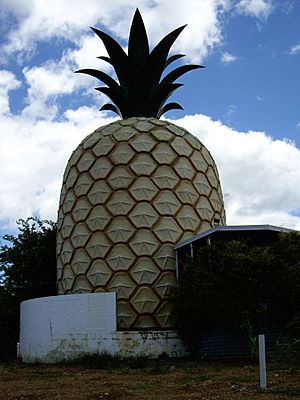
About 15 minutes south-east of Gympie, subtropical rainforest and spectacular rocky creeks make the Mothar Mountain rock pools a popular retreat for locals and visitors. Crystal-clear water gently cascades over ancient granite outcrops at Woondum National Park. Facilities include picnic tables, barbecues, firewood, fresh water, amenities, and bush-walking tracks. Access is by dirt road and requires a four-wheel-drive vehicle.
About 30 minutes' drive east of Gympie is Tin Can Bay, where one can hand-feed rare Indo-Pacific hump-backed dolphins in their natural environment. The feeding is regulated for the protection of the dolphins. Tin Can Bay is the southern access point to the Great Sandy Strait, a stunning aquatic playground protected by World Heritage-listed Fraser Island. The strait is an important ecological area with marine turtles, dolphin pods, dugongs, migrating humpback whales and valuable roosting area for migratory birds.
Gympie, Mary Valley, Tin Can Bay, Rainbow Beach, and Cooloola are part of the Great Sandy Biosphere which gives worldwide recognition of the outstanding natural beauty and high levels of biodiversity in this region.
The alleged Gympie Pyramid is also a minor attraction.
Gympie Cemetery Crawls are run by the Gympie Family History Society. Participants learn more about the pioneering families that created the town.
Transport
Road connection to Gympie is via the Bruce Highway. Rail connects via QR's North Coast railway line, which is served by daily Queensland Rail City network services to Brisbane and Traveltrain services for long distances. There are few public buses in Gympie and automobiles are the main mode of transportation.
Gympie Airport is a small local airport located to the south of the city. It has general aviation, recreational aviation and gliding communities.
Traveston Crossing Dam
The Queensland Government had plans to build a dam on the Mary River at Traveston Crossing, about 16 kilometres (9.9 mi) south of Gympie, arguing that there is sound geology and that the South East Queensland region needed greater water security due to the threat of climate change and population growth. The project was scrapped in 2010.
The proposed dam would have flooded about 900 properties. The affected land owners and other shire residents staged rallies protesting against the proposed dam. Strong opposition to the dam from the wider and international community based on environmental concerns related to the endangered Mary River cod, Mary River turtle, giant barred frog, Cascade tree frog and Coxen's fig parrot and the vulnerable Queensland lungfish, tusked frog, honey blue-eye fish, the Richmond birdwing butterfly and the Illidge's ant blue butterfly finally shut down the project.
Education
Gympie has many schools, reflecting its importance as a regional service centre. State primary schools include:
- Gympie West State School opened on 28 January 1958.
- Chatsworth State School opened on 18 April 1900.
- Monkland State School opened on 24 September 1884.
- Jones Hill State School opened on 29 January 1902.
- Gympie Central State School opened on 18 October 1869.
- Two Mile State School opened on 9 July 1883.
- One Mile State School was the first school opened in Gympie on 20 September 1869 as One Mile Boys State School with the One Mile Girls and Infants State School opening in October 1874. In January 1943, they were merged into One Mile State School.
- Gympie East State School opened on 25 January 1965.
- Gympie South State School opened on 4 July 1910.
State secondary schools include:
- James Nash State High School opened on 24 January 1977.
- Gympie State High School opened on 29 January 1912. This school is one of the oldest state secondary schools in Queensland.
Private schools offer both primary and secondary education. They include Victory College, Cooloola Christian College and St Patrick's. St Patrick's College in Gympie opened on 30 December 1916.
Gympie is home to one campus of the Wide Bay Institute of TAFE located on Cartwright Road.
The University of the Sunshine Coast (USC) has a campus in Gympie located on Cartwright Road. This campus offers undergraduate study in primary education, nursing, business, and commerce.
Notable people
- The Amity Affliction – musicians
- John Francis (Frank) Barnes – politician
- John O'Connell Bligh – Native Police Commandant
- Allan Boase – Australian Army Lieutenant General
- Henry Ernest Boote – writer
- Glen Boss – jockey
- Archie Bradley – boxer
- Jimmy Downey – football player
- Thomas Dunstan – politician
- Hugo William Du Rietz – gold miner, architect
- Tino Fa’asuamaleaui - NRL Rugby League Player
- Andrew Fisher – Australian Prime Minister
- Sir Thomas William Glasgow – Australian Army Major General
- Kaden Groves – professional cyclist
- Darren Hanlon – musician
- Peter Hanlon – sports writer
- Kenneth Hayne – Supreme Court Justice
- Trevor Housley – Postmaster-General
- Angus Finlay Hutton – naturalist
- Thelma Keane – businesswoman
- James Kidgell – politician
- Tracey Lewis – paralympic swimmer
- George Mackay – politician
- Barry McTaggart – rugby player
- Mathew Mellor – politician
- James Nash – prospector
- Tom Petersen – veteran, comedian.
- Francis Isidore Power – politician
- Gregory Charles Rivers – actor
- Marjorie Roche – Red Cross nurse
- Christopher Scott – paralympic cyclist
- Sir Christopher Sheehy – dairy industry administrator
- Ann Caroline Sherry AO – businesswoman
- Jacob Stumm – newspaper owner
- Harry Sunderland – rugby administrator
- Vivian Tozer – politician
- Harry Frederick Walker - Member of the Queensland Legislative Assembly
Images for kids
See also
 In Spanish: Gympie para niños
In Spanish: Gympie para niños



